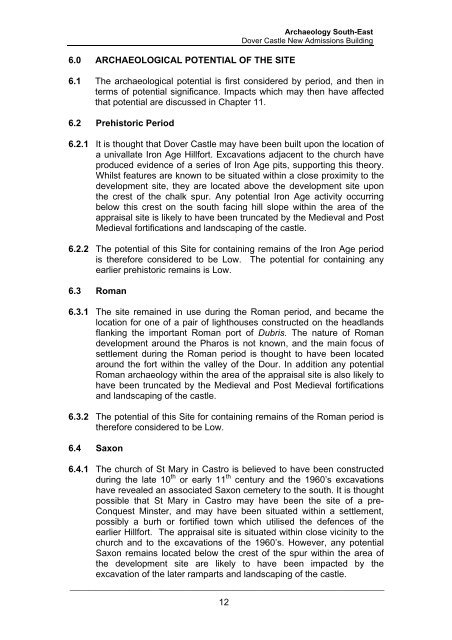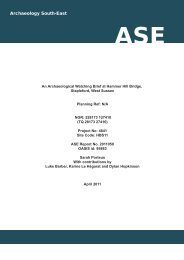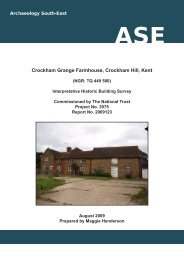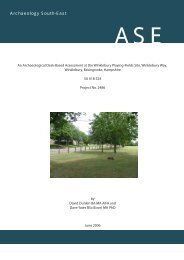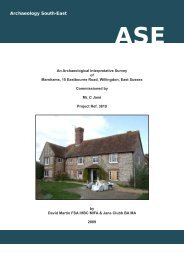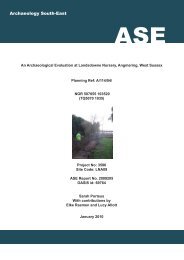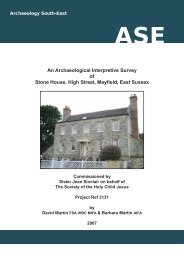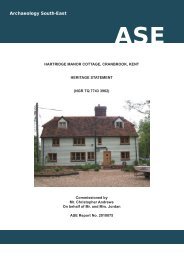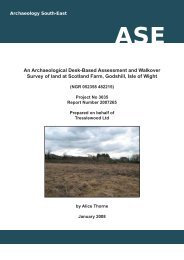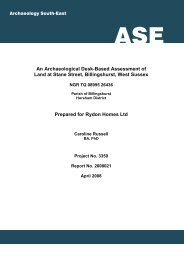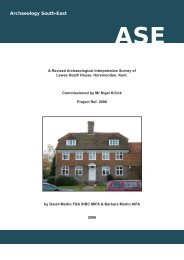ASE front cover 3127 Dover Castle - Archaeology South-East
ASE front cover 3127 Dover Castle - Archaeology South-East
ASE front cover 3127 Dover Castle - Archaeology South-East
You also want an ePaper? Increase the reach of your titles
YUMPU automatically turns print PDFs into web optimized ePapers that Google loves.
6.0 ARCHAEOLOGICAL POTENTIAL OF THE SITE<strong>Archaeology</strong> <strong>South</strong>-<strong>East</strong><strong>Dover</strong> <strong>Castle</strong> New Admissions Building6.1 The archaeological potential is first considered by period, and then interms of potential significance. Impacts which may then have affectedthat potential are discussed in Chapter 11.6.2 Prehistoric Period6.2.1 It is thought that <strong>Dover</strong> <strong>Castle</strong> may have been built upon the location ofa univallate Iron Age Hillfort. Excavations adjacent to the church haveproduced evidence of a series of Iron Age pits, supporting this theory.Whilst features are known to be situated within a close proximity to thedevelopment site, they are located above the development site uponthe crest of the chalk spur. Any potential Iron Age activity occurringbelow this crest on the south facing hill slope within the area of theappraisal site is likely to have been truncated by the Medieval and PostMedieval fortifications and landscaping of the castle.6.2.2 The potential of this Site for containing remains of the Iron Age periodis therefore considered to be Low. The potential for containing anyearlier prehistoric remains is Low.6.3 Roman6.3.1 The site remained in use during the Roman period, and became thelocation for one of a pair of lighthouses constructed on the headlandsflanking the important Roman port of Dubris. The nature of Romandevelopment around the Pharos is not known, and the main focus ofsettlement during the Roman period is thought to have been locatedaround the fort within the valley of the Dour. In addition any potentialRoman archaeology within the area of the appraisal site is also likely tohave been truncated by the Medieval and Post Medieval fortificationsand landscaping of the castle.6.3.2 The potential of this Site for containing remains of the Roman period istherefore considered to be Low.6.4 Saxon6.4.1 The church of St Mary in Castro is believed to have been constructedththduring the late 10 or early 11 century and the 1960’s excavationshave revealed an associated Saxon cemetery to the south. It is thoughtpossible that St Mary in Castro may have been the site of a pre-Conquest Minster, and may have been situated within a settlement,possibly a burh or fortified town which utilised the defences of theearlier Hillfort. The appraisal site is situated within close vicinity to thechurch and to the excavations of the 1960’s. However, any potentialSaxon remains located below the crest of the spur within the area ofthe development site are likely to have been impacted by theexcavation of the later ramparts and landscaping of the castle._____________________________________________________________________12


